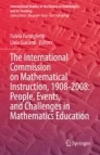One of the oldest and most influential international organizations for advancing mathematics education, the International Commission on Mathematical Instruction (ICMI) has had a symbiotic relationship with the history of mathematics education throughout its existence. After all, ICMI was originally conceived by
David Eugene Smith (1860–1944), who was instrumental in establishing both history of mathematics and mathematics education as academic disciplines in the United States. Since the late 20th century, a number of ICMI members have raised the profile of the history of mathematics education through, for example, the biennial International Conference on the History of Mathematics Education and 10 volumes of an
International Journal for the History of Mathematics Education (2006–2015). Additionally, they have documented the history of ICMI itself. In particular, ICMI’s centennial in 2008 was marked by publications such as:
- Marta Menghini, Fulvia Furinghetti, Livia Giacardi, and Ferdinando Arzarello, eds., The First Century of the International Commission on Mathematical Instruction (1908–2008) (Rome: Instituto Della Enciclopedia Italiana, 2008). See the publisher’s prospectus and the review by Michael N. Fried in ZDM – Mathematics Education 41, no. 4 (2009): 521–524.
- Ferdinando Arzarello, Livia Giacardi, Fulvia Furinghetti, and Marta Menghini, “Celebrating the first century of ICMI (1908-2008): Some aspects of the history of ICMI,” In Regular Lectures, 65–93, Proceedings of ICME-11, Monterrey, Mexico, 2008.
- Fulvia Furinghetti and Livia Giacardi, “People, Events, and Documents of ICMI’s First Century,” Actes d’Història de la Ciència i de la Tècnica 3, no. 2 (2010): 11–50.
- Fulvia Furinghetti and Livia Giacardi, eds., The First Century of the International Commission on Mathematical Instruction (1908–2008): History of ICMI (website, last updated 25 June 2020).
The current volume revisits, combines, and builds upon all of these earlier works. For instance, it contains historical essays, unlike the website, and these essays are gathered together in one section of the book, unlike The First Century. As in that book, Gert Schubring analyzes the early years of ICMI. Furinghetti then teams with Giacardi to explore the key decades of the 1950s and 1960s that they previously wrote about with Menghini and Arzarello. Menghini provides a new study of ICMI’s work over the past 50 years, including accounts of the International Congresses on Mathematical Education (ICMEs), involvements in organizations such as UNESCO, and the formation of affiliated study groups. Finally, Giacardi has collected and annotated 68 pieces of correspondence spanning 1908 to 1974 from the International Mathematics Union Archive and other locations. These materials do not appear to be available in print anywhere else, and most of the letters written in German have been translated into English.
The second section of this volume contains factual information and records for various aspects of ICMI: a revised (and unillustrated) version of the timeline from the website; lists of central and executive committee members; reprints of the governing documents (“terms of reference”) that were in force from 1954 to 2007; notes on the mathematics education content presented during International Congresses of Mathematicians (ICMs) between 1897 and 2006; maps depicting the international expansion of ICMI; and lists of participants and presentation titles from ICME-1, held in Lyon in 1969. This is the shortest part of the book. Scans of additional documents and publications—such as circulars (1908–1934), questionnaires (1908–1959), and Bulletins (1972–1998)—are available on the website, although many of the questionnaire links were broken at the time this review was written.
The third and longest part of this volume provides lightly-edited versions of the biographical essays found on the website. These portraits cover 54 executive committee members who died before 2008 and 9 honorary members of ICMI. They were prepared by 30 different authors, including the editors, Giacardi, Jeremy Kilpatrick, Ewa Lakoma, Adrian Rice, Schubring, Man Keung Siu, and Henrik Kragh Sørensen. Taken as a whole, the biographies highlight themes such as the important contributions by leaders from East Asia and Eastern Europe and the interplay between theoretical research in mathematics and activity in mathematics education. The volume closes with author and subject indexes.
For a Springer volume, the price of this book is not exorbitant. It is perhaps particularly valuable for ensuring that many of the website materials will be permanently preserved. Like the online repository, the book is a testament to the thousands of hours invested by the editors to record and share the history of ICMI with anyone who has an interest in mathematics education. Its focus on primary sources and data nicely complements the varied perspectives found in The First Century. Thus, it is worth acquiring by any college or university library with a mathematics education program and by historians of mathematics education.
Amy Ackerberg-Hastings co-edits MAA Convergence with Janet Heine Barnett and the CSHPM Notes column in Notes of the Canadian Mathematical Society with Hardy Grant. Her research interests include the history of mathematics education and the sociology of professional organizations.






